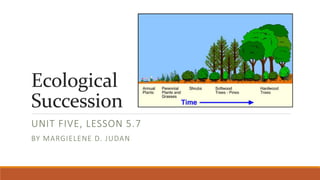
Ecological Succession from Bare Rock to Forests
- 1. Ecological Succession UNIT FIVE, LESSON 5.7 BY MARGIELENE D. JUDAN
- 2. LESSON OUTLINE Ecological Succession Primary and Secondary Succession Succession from Bare Rock Succession from Disturbed Vegetation
- 3. Have you ever visited an open field? What did you observe? What organisms are commonly could living there?
- 4. If you have the chance to come back and visit the same place again after 15 years, do you think everything will be the same as before?
- 5. The next slide is a video animation that will give you an overview of our lesson today.
- 7. Ecological succession is the gradual process by which ecosystems change and develop over time. Nothing remains the same and habitats are constantly changing.
- 10. Two Types of Ecological Succession 1. Primary - the series of community changes which occur on an entirely new habitat which has never been colonized before. 2. Secondary - the series of community changes which take place on a previously colonized, but disturbed or damaged habitat.
- 13. Primary succession is a very long process, usually 100s to 1000s of years.
- 14. In primary succession, there is no trace of a previous community.
- 15. Nonliving to living community Starts with no soil
- 16. Primary succession examples: 1. Succession from a newly quarried rock 2. A new island formed by volcanic activity 3. Succession of sand dunes
- 17. Primary succession example: Lawahii was formed by the eruption of an undersea volcano in the middle of the Pacific Ocean west of Hawaii and east of Japan. After hundreds of years plants sprouted on Lawahii. The gradual growth of vegetation in Lawahii is an example of primary succession. The pattern of primary succession is from no soil and being covered in ash and rock to the growth of pioneer species such as lichens and moss to developing weeds, shrubs and trees. Lawihii born after volcanic eruption; notice that it has no living forms in it
- 18. While in secondary succession, it happens in an area that has been previously disturbed or destroyed. Living ecosystem > destroyed by calamity > regrowth of the ecosystem
- 19. It occurs where soil is present.
- 20. It happens more rapidly than primary succession because some soil and seeds are left in the area.
- 21. Secondary succession examples: 1. Succession of abandoned forest 2. Succession of a burned forest 3. Succession after deforestation
- 22. Secondary succession example: Several centuries after the island of Lawahii formed, a fire boke out killing all of the vegetation and animals that thrived on this ecosystem. Plants gradually begun to grow once again on this island. Plants growing once again on Lawahii after a disturbance such as a fire are examples of secondary succession. The pattern of secondary succession is from as ecosystem being disturbed by man or elemental forces to growing annual plants which are then followed by perennial plants to the growth of shrubs and eventually the growth of trees. Secondary succession is much more rapid than primary succession since the vital elements such as soil, nutrients and seeds are already present at the location at least to some extent.
- 23. Succession from a bare rock The video we watched earlier is an example of a primary succession from a bare rock
- 24. Copy and memorize these steps.
- 25. Succession from a bare rock 1. Bare rock, no organisms - Glacier leaves behind bare rock; Volcano produces bare rock with no organisms. 2. Pioneer species begins breaking down rock. Pioneer species: 1st organism to live in an area. Pioneer species, usually lichens, grows on rock. Lichens secrete acids that begin breaking rock into small particles, which mix with lichen remains to begin making soil.
- 26. Succession from a bare rock 3. More complex plants, usually mosses, begin growing when soil is deep enough, after many years; eventually replace (succeed) lichens. Tiny organisms such as insects move in, add their remains to soil. 4. Larger, more complex plants: As soil gets thicker ferns succeed mosses. Grasses and wildflowers may succeed ferns. When enough soil has developed, shrubs and small trees move into the area. 5. Forests: Soil may be deep enough after hundreds or thousands of years for pine or hardwood forests.
- 27. Succession from a disturbed vegetation Kaingin is a slash-and-burn system of farming that can destroy a previous ecosystem
- 28. Copy and memorize these steps.
- 29. All things undergo succession (they change). This image is an example of aquatic to land community.
- 30. Aquatic to Land Community Succession
- 31. Though succession brings about many positive effects, including the birth of a new ecosystem, it can also bring about negative changes. Because of human exploitation of resources, our forests have roughly decreased over the century.
- 32. Some negative effects 1. Kaingin, deforestation and illegal logging destroys forests and harms wildlife to extinction. 2. Removing forests promotes soil erosion, making areas more vulnerable to floods and landslides. 3. To much exploitation exhausts resources (such as fossil fuels). We should learn and apply the 3Rs (reduce, reuse, recycle). 4. Land, water and air pollution